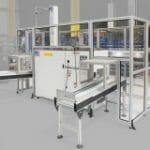Space limitations are often cited as a barrier for automation in production and packing plants. When room is tight, Pacepacker Services has just developed and launched a fitting and more compact solution, a new Cartesian palletising system which typically takes up just 4.3m2 of floor space – delivering an impressive 50% reduction in floor footprint compared to a comparable robotic arm solution.
Situated at the end of an existing product conveyor, Pacepacker’s Compact Cartesian Palletiser is ideal for handling retail and wholesale goods in clusters, such as blister packs of flour and trays of jam jars, as well as boxes, cartons, shrink-wrapped trays and many other retail goods.
Unveiled at Lamma 2015, the simple design comprises a robust frame straddling the end-of-line conveyor. A Cartesian mechanism supplied by Festo is built into the overhead area and an empty pallet is placed neatly on the floor within the structure. As product feeds along the conveyor, they are picked up and placed onto the pallet.
The most appropriate end-effector for each application is added to the Cartesian device, typically an electro-magnetic or vacuum gripper, giving packing facilities a standalone palletising solution for accurate and efficient handling of materials. Throughput speed depends on the volume and type of product being handled in each movement, but is typically around 6 per minute for shrink-wrapped flexible packs like shrink-wrapped bundles of flour, and 10 per minute for ridged cardboard boxes, these speeds could be increased if multi picking is an option.
“Over the years, production facilities have got increasingly congested due to more lines being added,” highlights Paul Wilkinson, Pacepacker’s Business Development Manager. “Automation solutions for end-of-line palletising can be very bulky. However, the Cartesian unit is very space efficient and eliminates one of the most arduous and labour intensive tasks, boosting hourly throughput by almost 100% in some cases.”
To illustrate the floor footprint saving, a comparable robotic palletiser takes up around 8.6m2. Compare this to the Compact Cartesian Palletiser at 4.3m2; a typical packing facility will have 50% more floor space to play with. “The only other way to accomplish the same function as the Compact Cartesian Palletiser in a similar footprint, would be to go ‘old school’ reverting back to a human picking and placing product manually onto a pallet,” claims Paul. “What we’ve done is create a practical and cost efficient palletising alternative. Like many of our systems, a 12 month ROI is entirely feasible. The increased productivity gained by automating operations is certainly a compelling benefit, especially in the food sector where margins are being squeezed in every direction.”
Primarily designed for food processors and packers, the Compact Cartesian Palletiser is equally suitable for handling personal care products. “One of the key advantages of a Cartesian robot is its precision,” adds Paul. “It is also straightforward to programme.” With access to dozens of different end-effectors, customers can feel confident that whatever the application, Pacepacker will engineer a bespoke solution to suit, improving product quality, reducing waste and boosting throughput.
The first model was recently commissioned by a family-run flour farm, and was installed at the end of January 2015. Estimated timescales from order to delivery for the Compact Cartesian Palletiser are around 12 weeks.







Leave a Reply